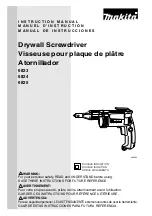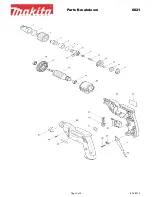
14
EN
O R I G I N A L I N S T R U C T I O N S
not allow for safe operation and control of the tool in dangerous situations.
Repairs
Repair the power tool only in authorized facilities using only original spare parts.
This ensures proper operation safety of
the power tool.
SAFETY WARNINGS FOR DRILLS
Safety instructions for all activities
Use hearing protectors when hammer drilling.
Exposure to noise can cause hearing loss.
Use the additional handle(s).
Loss of control can cause personal injury.
Grasp the tool properly before use.
This tool generates high torque and when it is not properly held during operation, loss of
control can cause personal injury.
Hold the tool by the insulated handles when working where the cutting accessory may come into contact with the hidden
cord or supply cable.
Cutting accessory coming into contact with a live wire can cause the metal parts of the tool to become “live”
and cause an electric shock to the operator.
Safety instructions when using long drill bits
Never operate at a higher rotational speed than the maximum drill bit rotational speed.
At higher speeds, the drill bit will
probably bend and cause personal injury if it is allowed to rotate freely without contact with the workpiece.
Always start working at low speed and when the end of the drill bit is in contact with the workpiece.
At higher speeds, the
drill bit will probably bend and cause personal injury if it is allowed to rotate freely without contact with the workpiece.
Apply pressure only in the direction of the drill bit axis. Do not apply excessive pressure.
The drill bit can bend, causing
breakage or loss of control which will result in personal injury.
PREPARING FOR WORK
CAUTION! All activities listed in this section must be carried out with the supply voltage disconnected – the battery must be dis-
connected from the tool!
Safety instructions for battery charging
Caution!
Before starting charging, make sure that the power unit body, cord and plug are not cracked or damaged. It is forbidden
to use a defective or damaged charging station and power unit! Use only the supplied charging station and power unit to charge
the batteries. The use of another power unit may result in
fi
re or damage to the tool. The battery should only be charged in a
closed, dry room, protected against unauthorised access, especially by children. Do not use the charging station and power unit
without the constant supervision of an adult! If you need to leave the room where the tool is being charged, disconnect the charger
from the mains by removing the power unit plug from the mains socket. If smoke, suspicious odours, etc. are escaping from the
charger, remove the charger plug from the mains socket immediately!
The drill driver is supplied with an uncharged battery and should therefore be charged according to the procedure described be-
low with the included power unit and charging station before use. Li-ion (lithium-ion) batteries do not have the so-called “memory
e
ff
ect”, which means they can be recharged at any time. However, it is recommended to discharge the battery during normal
operation and then charge it to full capacity. If, due to the nature of work, it is not possible to use the battery in such a manner
every time, it should be done at least every several work cycles. Never discharge any batteries by short-circuiting the battery
plates, as this will cause irreparable damage! In addition, do not check the battery charge status, by short-circuiting the plates
and checking their sparking.
Battery storage
Ensure the proper storage conditions to extend the battery’s life. The battery can withstand approximately 500 charge-discharge
cycles. Store the battery at a temperature ranging from 0ºC to 30ºC at a relative air humidity of 50%. Charge the battery to approx.
70% of its total capacity to store it for a longer period of time. In case of prolonged storage, the battery should be periodically
charged once a year. Do not over-discharge the battery as this will shorten its life and may cause irreparable damage.
During storage, the battery will gradually discharge due to leakage. The self-discharge process depends on the storage tempera-
ture – the higher the temperature, the faster the discharge process. If the batteries are stored incorrectly, the electrolyte may leak.
In case of leakage, secure the leak with a neutralising agent. In the case of electrolyte contact with eyes, rinse eyes thoroughly
with water, and immediately seek medical attention.
It is not allowed to use the tool with a damaged battery.
If the battery is completely worn, return it to a specialist waste disposal centre.
Battery transport
Lithium-ion batteries are treated as hazardous goods, according to legal regulations. The user of the tool can transport the product
together with the battery and the batteries alone by land. In that case, no additional conditions have to be met. If you entrust trans-
port to third parties (e.g. a courier company), follow the regulations regarding the transport of hazardous goods. Before shipping,
Содержание YT-82790
Страница 25: ...25 RU residual current device RCD...
Страница 26: ...26 RU...
Страница 27: ...27 RU Li Ion 500 0 30 50 70 II II...
Страница 28: ...28 RU III IV VI VII VIII IX X...
Страница 29: ...29 RU 60 C 0 3 MPa...
Страница 31: ...31 UA residual current device RCD...
Страница 32: ...32 UA...
Страница 33: ...33 UA 500 0 30 50 70 II II...
Страница 34: ...34 UA IV VI VII VIII IX X...
Страница 35: ...35 UA 60O C 0 3 MPa...
Страница 97: ...97 GR RCD RCD...
Страница 98: ...98 GR...
Страница 99: ...99 GR Li Ion 500 0 30 50 70 LED LED LED LED LED...
Страница 100: ...100 GR LED III IV VI V VII IX X...
Страница 101: ...101 GR 60 o C 0 3 MPa...
Страница 103: ...103 BG RCD RCD...
Страница 104: ...104 BG 130O C...
Страница 105: ...105 BG Li Ion 500 0 30 50 70...
Страница 106: ...106 BG II II III IV VI VII...
Страница 107: ...107 BG VIII IX X...
Страница 108: ...108 BG 60o C 0 3 MPa...
Страница 112: ...I N S T R U K C J A O R Y G I N A L N A 112...















































